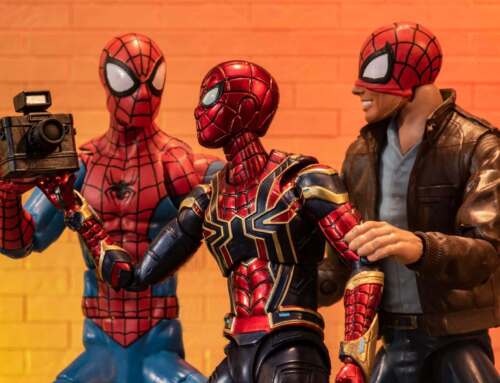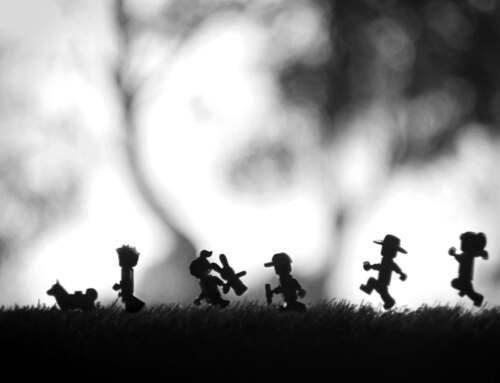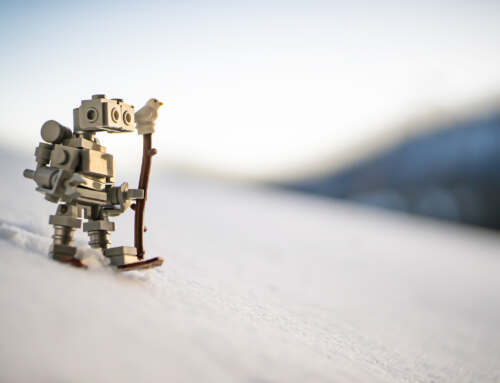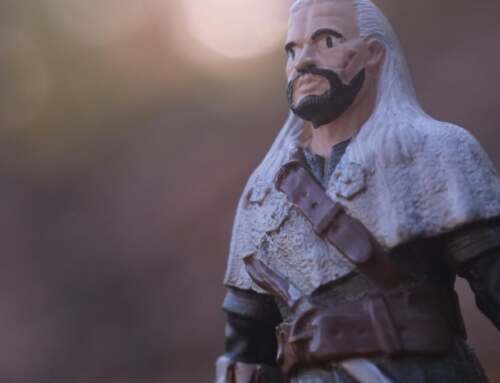Every once in a while I see a meme go around that uses a certain photo from World War II. Often it is used to express how awesome the Greatest Generation is. A recent example from my social feeds is this one:

This has always both amused me and annoyed me. Not because it suggests the WWII generation is great. Far from it. I have a lot of respect for that generation for literally kicking the ever-loving crap out of the Nazis. That generation is directly responsible for many of the freedoms a large portion of us enjoy today (including, interestingly enough, Germany).
The reason for my annoyed reaction—this photo is not from WWII. It doesn’t even contain real people. It was made sometime between 2001–2002 by a toy photographer named Mark Hogancamp. Here’s the original image:

If you are a fan of toy photography you’ve likely come across the story of Mark Hogancamp. We’ve covered the topic many times on this blog, but for those who don’t know: The short history is that in the year 2000, Hogancamp was the victim of a hate crime. He was severely beaten by three people outside a bar in Kingston, New York, and was left with severe physical and mental trauma. To help him cope with his experiences, Hogancamp started building a 1/6 scale world of his own, set during World War II, in a town called Marwencol. He took photos to tell stories about the citizens of Marwencol and their adventures. The above photo in question is a result of that.
The struggle is real
So when I see this image being hailed as an example of a real image, my first reaction is to smugly point out, “Hey, this ain’t real, yo” (my exact inner dialog, true story). Then I think of how interesting it is that toy photography can be so realistic that people believe it’s real. I get a certain sense of satisfaction out of this, as realism is something I strive for in my own work. (Being realistic is absolutely not a requirement of toy photography—a lot of my favourite work isn’t realistic at all, but the fact that toys can be passed off as realistic fascinates me, and is one thing that keeps me personally creating the art I do.)
Then I think of Hogancamp and the trauma he went through. The agony of living with the mental trauma he suffered must be unbearable at times, and the fact that he found an outlet to both express and try to understand his new reality is fascinating. He used his mental illness to create real works of art, and though he likely didn’t mean to (I am reading into things here, but I suspect I am correct), Hogancamp touched a lot of lives by doing so—including my own.
Hitting close to home
You see, I also suffer from mental illness. I have been living with depression my whole life, and was diagnosed with moderate severe depression a couple of years ago. Fortunately, unlike Hogancamp, mine is not the result of trauma. My depression appears to be a chemical imbalance in my brain that affects my serotonin, the chemical that helps regulate mood (among other things) in my brain. (I wrote about my experiences in a post called Toy Photography and the Beast of Depression). One thing I’ve learned about mental illness is that it is more common than I ever realized. So many people I know—people I never would have even suspected—have told me, “Yeah, me too,” after I shared my diagnosis.
Incidents of depression have increased a lot over the past year or so. We’ve all been through a global pandemic, and we’re still in the midst of it. Even if we are lucky enough for it to not affect us that much, the constant worry and uncertainty constantly weighs us all down mentally and emotionally. For some of us our emotional energy—the energy we use to deal with our emotions, either good or bad—simply runs out, and we hit a wall. That wall is often a sign of mental illness.
The range of mental illnesses and their effects are as vast as any other group of illnesses. It affects us all differently. Sometimes it comes and goes, sometimes the symptoms are constant. It can be caused by physical trauma, dramatic life events or just chemical imbalances in the brain. For some it’s just a minor blip. For others it sucks them down a windy spiral to the darkest of places. Sometimes it’s a single instance that can be addressed and never occur again, and sometimes it’s a lifelong struggle.
You are not alone
Regardless of what it is, if you are affected, getting help is vital to the treatment process. If you are feeling down, and your mood and energy changes, seek help. The old adage, “smile and you’ll feel better,” may just work for you. Sometimes going for a walk or getting lost in the creative process is enough to recharge our emotional energy. Give it a try—it can’t hurt. However that doesn’t work for everyone. Sometimes true and proper medical advice is needed. If you break your arm, have high blood pressure or some other illness, you’d see a doctor. Your brain should be no exception to that. There is no shame in getting help.
So if you are feeling like the world is weighing heavily on your shoulders, and you just don’t know if you’ll ever get out of it, then please reach out and get help. Depending on what country you are in, that help may be reached in different ways. A good start is to talk to your doctor—that’s how I found help. You may also want to call the Suicide Prevention Hotline (1-800-273-8255) in the US. Or Google one for your own country. You can also call an emergency line like 911 or 999.
If you are reading this, it’s more than likely you are a toy photographer, an artist of some other kind or a personal friend of mine (hi, everyone!). I don’t want the world to be deprived of your art or your friendship. So if you need help, please reach out.
In the meantime, keep doing what you do. The world is a better place for it.
[dave]
Want more toy photography goodness? Subscribe to our weekly email round up so that you never miss a post. Find previous episodes of the podcast! If you are suffering from depression or other mental illness, please seek help. We all need a helping hand sometimes, and it will get better in time.







Leave A Comment